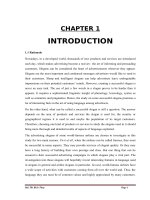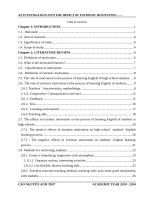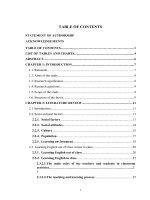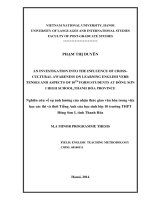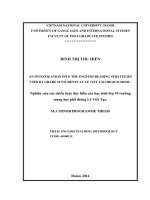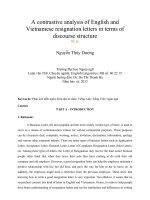an investigation into the english language used on facebook social network by vietnamese learners of english = nghiên cứu về ngôn ngữ anh được người học tiếng anh ở việt nam sử dụng trên mạng xã hội facebook
Bạn đang xem bản rút gọn của tài liệu. Xem và tải ngay bản đầy đủ của tài liệu tại đây (1.18 MB, 58 trang )
VIETNAM NATIONAL UNIVERSITY HANOI
UNIVERSITY OF LANGUAGES AND INTERNATIONAL STUDIES
FACULTY OF POST-GRADUATE STUDIES
NGUYỄN THỊ LINH
AN INVESTIGATION INTO
THE ENGLISH LANGUAGE USED ON
FACEBOOK SOCIAL NETWORK BY
VIETNAMESE LEARNERS OF ENGLISH
(NGHIÊN CỨU VỀ NGÔN NGỮ ANH ĐƯỢC NGƯỜI
HỌC TIẾNG ANH Ở VIỆT NAM SỬ DỤNG TRÊN
MẠNG XÃ HỘI FACEBOOK)
M.A. MINOR THESIS
Field: English Linguistics
Code: 60.22.0201
HANOI – 2013
VIETNAM NATIONAL UNIVERSITY HANOI
UNIVERSITY OF LANGUAGES AND INTERNATIONAL STUDIES
FACULTY OF POST-GRADUATE STUDIES
NGUYỄN THỊ LINH
AN INVESTIGATION INTO
THE ENGLISH LANGUAGE USED ON
FACEBOOK SOCIAL NETWORK BY
VIETNAMESE LEARNERS OF ENGLISH
(NGHIÊN CỨU VỀ NGÔN NGỮ ANH ĐƯỢC NGƯỜI
HỌC TIẾNG ANH Ở VIỆT NAM SỬ DỤNG TRÊN
MẠNG XÃ HỘI FACEBOOK)
M.A. MINOR THESIS
Field: English Linguistics
Code: 60.22.0201
Supervisor: Kiều Thị Thu Hương, PhD.
HANOI – 2013
DECLARATION
I hereby, certify the thesis entitled “An investigation into the English language used
on Facebook social network by Vietnamese learners of English” is the result of my
own research for the Minor Degree of Master of Arts at University of Languages
and International Studies, Vietnam National University, Hanoi. The thesis has not
been submitted for any degree at any other universities or institutions. I agree that
the origin of my paper deposited in the library can be accessible for the purposes
of study and research.
September, 2013
Nguyễn Thị Linh
i
ACKNOWLEDGEMENTS
I would like to show my gratitude to all those who gave me the possibility to
complete this thesis.
I have sincere thanks to the Post-graduate Department of ULIS, VNUH for giving
me permission to commence and go ahead with this M.A. thesis and to use
departmental data.
I am deeply indebted to my supervisor, Dr. Kiều Thị Thu Hương, Vice-Dean of the
English Faculty – Diplomatic Academy of Vietnam, whose encouragement,
guidance and support enabled me to develop an understanding of the subject and to
accomplish the final version of the thesis as expected.
This thesis would not be possible were it not for my lecturers in the M.A. course,
namely Prof. Dr. Hoàng Văn Vân, Assoc. Prof. Dr. Lê Hùng Tiến, Assoc. Prof. Dr.
Võ Đại Quang, Dr. Hà Cẩm Tâm, Dr. Nguyễn Huy Kỷ, Dr. Ngơ Hữu Hồng, Dr. Lê
Văn Canh and Dr. Huỳnh Anh Tuấn. I would like to thank them for their interesting
lectures, devotion, assistance and valuable hints.
Especially, I owe my deepest gratitude to my parents whose endless love and
encouragement helped me finish this work.
Lastly, I offer my regards and blessings to all of those who supported me in any
respect during the completion of the study.
ii
ABSTRACT
Languages in general and English in particular evolve and diversify over the time.
Especially with the outburst of computer-mediated communication like the social
network Facebook, English language incessantly gets its new look.
The undertaken research examines the statuses and comments published on the
Facebook sites of Vietnamese graduates of English to observe the trendy features of
English language. The level of formality/informality of online written English is
considered as well. The study focuses on the main aspects of the language‟s
grammar, namely morphology, syntax and punctuation.
Thanks to the descriptive, analytic, comparative and contrastive methods, the results
reveal the tendency of the participants‟ using abbreviated expressions on Facebook.
This also proves their preference of maintaining informality on this social network.
Nevertheless, most instances indicate the hesitation of Vietnamese graduates of
English in creating brand-new English, which now becomes the trend of Facebook
users.
iii
TABLE OF CONTENTS
DECLARATION ..................................................................................................... i
ACKNOWLEDGEMENTS ................................................................................... ii
ABSTRACT ........................................................................................................... iii
LIST OF FIGURES AND TABLES .................................................................... vi
ABBREVIATIONS AND CONVENTIONS ...................................................... vii
PART I – INTRODUCTION ................................................................................ 1
1. Statement of the problem................................................................................ 1
2. Objectives of the study .................................................................................... 2
3. Research questions .......................................................................................... 2
4. Significance of the study ................................................................................. 3
5. Scope of the study ............................................................................................ 4
6. Design of the study .......................................................................................... 5
PART II – DEVELOPMENT ............................................................................... 6
CHAPTER I: LITERATURE REVIEW ............................................................. 6
1.1.
Written English ....................................................................................... 6
1.1.1.
Morphology........................................................................................ 6
1.1.2.
Syntax................................................................................................. 9
1.1.3.
Punctuation ...................................................................................... 16
1.2.
English phonemes ................................................................................. 16
1.3.
Informal English ................................................................................... 18
1.4.
Conversations ........................................................................................ 19
1.5.
Review of related studies ...................................................................... 19
CHAPTER II: THE STUDY ............................................................................... 22
2.1.
Methodology .......................................................................................... 22
2.1.1.
Subjects ............................................................................................ 22
2.1.2.
Data gathering instruments .............................................................. 22
2.1.3.
Procedure ......................................................................................... 23
2.2.
Findings and discussion ........................................................................ 24
iv
2.2.1.
Morphology...................................................................................... 25
2.2.2.
Syntax............................................................................................... 32
2.2.3.
Punctuation ...................................................................................... 39
2.2.4.
Discussion ........................................................................................ 40
PART III – CONCLUSION ................................................................................ 42
3.1.
Conclusions ............................................................................................ 42
3.2.
Limitations of the study ........................................................................ 43
3.3.
Suggestions for further study............................................................... 43
REFERENCES ........................................................................................................ I
ENGLISH .............................................................................................................. I
VIETNAMESE .................................................................................................. IV
APPENDIX .............................................................................................................V
v
LIST OF FIGURES AND TABLES
Figures
Figure 1 - The preference of each abbreviated form ................................................25
Figure 2 - Proportion of phrase types on Facebook status .......................................33
Figure 3 - Proportion of sentence types on Facebook status ....................................37
Figure 4 - Proportion of sentence types on Facebook comment ............................... 38
Tables
Table 1 - Chart of English consonant phonemes ......................................................17
Table 2 - List of Sound-based Substitutes on Facebook ...........................................27
Table 3- List of Initialisms on Facebook ..................................................................28
Table 4 - List of Clippings on Facebook ...................................................................30
Table 5 - List of Sound Imitations on Facebook .......................................................31
Table 6 - List of Colloquialisms on Facebook ..........................................................32
vi
ABBREVIATIONS AND CONVENTIONS
A
Adverbial
Adj
Adjective
AdjP
Adjective Phrase
Adv
Adverb
AdvP
Adverb Phrase
C
Complement
Comb
Combination
Exc
Exclamation
Int
Interjection
Mod
Modal (verb)
N
Noun
NP
Noun Phrase
O
Object
P
Preposition
PP
Prepositional Phrase
S
Subject
St
Sentence
SNS
Social Networking Site
ULIS
University of Languages and International Studies
VNUH
Vietnam National University, Hanoi
V
Verb
VP
Verb Phrase
&
and
i.e.
in other words
e.g.
for example
n.d.
no date
vii
PART I – INTRODUCTION
1.
Statement of the problem
Language is always a fertile field for linguistic researchers since it has incessantly
been renewed by users to get what they want to express. It is beyond doubt that
English has been used not only widely but also dissimilarly in different regions of
the world. For instance, the prepositional phrase „at the weekend‟, which is
preferred by British, turns to „on the weekend‟ in American English; or when you
hear an Australian say „sunnies‟, it means „sunglasses‟ in British and American
English. As an aspect of culture, language is “the system of communication in
speech and writing that is used by people of a particular country or area”1. In other
words, language in general and English in particular has been exploited by a certain
community that shares the same habits of using the linguistic patterns.
Thus, when it comes to Facebook, one of the most popular social networks, which
connects people all over the world, one issue raised is whether or not a new kind of
English will be created by Facebook users. It is the very founder of Facebook, Mark
Zuckerberg who declared that this social network was “helping to define a brandnew language for how people connect”2. He explained that vocabulary was really
limited, so adding nouns and verbs could help to express a large number of things
and connect to anything in any way we want. Therefore, Zuckerberg himself has
called Facebook users to create a language with pleasure.
Thanks to a wide coverage of Facebook, many Vietnamese learners of English
consider it a good site to practice the language by communicating with English
speakers. There are more and more Vietnamese people sharing their status and
language (n.d.). In Oxford Advanced Learners‟ Dictionary (8th ed.). Retrieved from
/>1
2
Zimmer, B. (2011, September). “The rise of the Zuckerverb: The new language on Facebook”. The Atlantic.
Retrieved from />
1
giving comments in English on Facebook. They are more likely to use English to
make Facebook users understand their expressions. However, what kind of English
do the Vietnamese utilize on Facebook? Do they prefer to use the Standard English
learnt at school/university or the created one? Hardly have any answers to these
questions been found in any research papers before.
Thus, the present study has been carried out to investigate the trendy features of
English used by Vietnamese learners of English on the social network Facebook.
2. Objectives of the study
The statuses and comments posted on Facebook are characterized as asynchronous,
that is, the mode of communication where the author and the reader are online at
different times (Yus, 2011). In contrast to synchronous communication,
asynchronicity allows selective message construction (Duthler, 2006), thus
language users are able to plan, review and control their texts more than in
synchronous media like chats. Consequently, asynchronous online communication
would allow a more formal style. Following this premise, the objectives of the study
will be twofold:
1)
To examine online English writings on Facebook to find out the trendy
features of this language when used by Vietnamese learners of English.
2)
To investigate the degree of formality/ informality followed by Vietnamese
learners of English on this social network site.
3. Research questions
The study aims at seeking answers to the following questions:
1) What are the trendy features of English language used on Facebook by
Vietnamese learners of English?
2) What is the degree of formality/ informality of English followed by
Vietnamese learners of English on Facebook?
2
4. Significance of the study
The paper is an attempt to look into an under-researched issue on Facebook and for
the Vietnamese graduates of English. Thus, once completed, its outcome may offer
benefits to entities involved, namely Vietnamese learners and teachers of English,
and other Facebook users in the world.
First of all, it is Vietnamese learners of English that benefit the most from the
results of this paper. This study partly helps them to differentiate Facebook English
from academic and business English: when the former is rather informal, the latter
seems to be more formal and standardized. As a result, they will be more aware of
using suitable English for different purposes, especially for some formal documents
like reports, business letters or researches.
In addition, for some Vietnamese undergraduates who have not had stable basic
background knowledge of English language yet, it is really risky if using Facebook
English becomes their habit. At that time, there is no doubt that they will
unconsciously bring what they read and see on Facebook to school, which leads to
their unavoidable mistakes in English. Thus, the findings of this study familiarize
Vietnamese teachers of English with forms of the uncommon language that their
students may use in class and that they consider errors or mistakes. Hence, teachers
can understand causes of the problems and find out appropriate solutions.
Furthermore, in regard to Facebook users in general, the research may provide them
with deep and comprehensive insight into the current situation of English used by
the Vietnamese. Hopefully, all of Facebook users can understand what their
Vietnamese interactants mean. This helps to connect more users on Facebook.
Last but not least, researchers of the related fields can use the current paper for
reference and carry out further and deeper investigation.
3
5. Scope of the study
According to Vietnam‟s Youth Magazine (2012)3, the majority of Vietnamese
accounts on Facebook are under the age of thirty-four. Besides, due to the fact that
Vietnamese graduates of English are more likely to use English on Facebook,
twenty-three- to thirty-three-year-old users have become the most suitable
informants of the study.
Additionally, there are several applications for Facebook users to communicate on
this social network such as private and public message, status, comment, note, chat,
voice and video call and so on, but some of them are hard to be observed and
intervened to study on the used language. Therefore, only status and comment have
been taken into consideration. As a result, written English has become a variable of
the study. However, despite numerous fields of English language, the research only
focuses on the aspects of morphology and syntax, the two main components of a
grammar (Huddleston & Pullum, 2002, p.4). Also, punctuation is concerned as the
study targets to written English.
Moreover, in regard to English, there exists a list of dialects of this language such as
British English, American English, Australian English, and Canadian English and
so on. Until now the issue called „Global English‟ is still a matter of argument,
hence the study needs to choose a Standard English to make comparison with the
one used on Facebook. In Huddleston and Pullum‟s (2002, p.4) theory, Standard
English “is the language of government, education broadcasting news publishing,
entertainment, and other public discourse”. Standard English in the twenty-first
century can be grouped into two regional dialects: British English and American
English (Huddleston & Pullum, 2002, p.5). Nevertheless, the researcher decided to
put only British English on one scale of comparison. The reason is
the scholarly interest in global English is of mainly British origin. The British
seem to be much more aware of the necessity of somehow overseeing the
development of global English.
Anderman (2005, p.147)
3
30,8 triệu người Việt Nam sử dụng Internet. (2012, Oct 19). Retrieved from
/>
4
6. Design of the study
The study includes three parts:
Part one is the Introduction of the study which states the problem, the research
questions, objectives, scope, significance and the design of the whole paper.
Part two is the Development which is composed of two chapters. Chapter one
presents the theoretical background related to the issue. Chapter two presents the
research methodology (i.e. subjects of the study, data collection instruments, and
procedure), findings (i.e. analysis of data, results) and discussion.
Part three is the Conclusion which summarizes significant findings of the
investigation, elaborates contributions of the research, puts forward practical
suggestions for future research as well as addresses notable limitations.
5
PART II – DEVELOPMENT
CHAPTER I: LITERATURE REVIEW
1.1.
Written English
The social network Facebook is the place for both spoken and written
communication. However, due to the scope of the study that only concentrates on
the applications of status and comment, written English has been under
investigation.
The nature of the written language is the medium and slower sentence-planning
environment with the construction of longer sentences in comparison with speech
(Huddleston & Pullum, 2002, p.13). As a standard, written English is encountered
in contemporary newspapers, magazines, and books. In order to get precise
sentences, writers of any language need to master its grammar composed of
morphology, syntax and punctuation.
1.1.1. Morphology
Morphology is the study of word structure (Quirk, Greenbaum, Leech & Svartvik,
1987). Words typically have internal structure; particularly they consist of smaller
units called morphemes (Aronoff, 1983). For example, the verb-form looked
consists of two morphemes: the verb-stem look and the grammatical ending -ed.
Similarly, the noun notebook consists of the morphemes note and book, and the
adverb beautifully consists of the morphemes beautiful and -ly.
1.1.1.1. Word formation
A word is an independent meaningful linguistic unit typically larger than a
morpheme but smaller than a phrase. Morphologically, words can be formed in
many processes which are presented as below based on the grammatical theories by
Quirk et al. (1987, p.430) and Huddleston (2002, p.1621).
6
•
Affixation – the formation of words by adding a prefix or a suffix to the
base, e.g. predict, presidential, informal.
•
Conversion – the word formation process of changing word-classes without
affix, e.g. import (used as a verb or a noun), abstract (used as a noun or an
adjective).
•
Compounding – the process of forming words from two or more bases, e.g.
greenhouse from green and house, desktop from desk and top.
•
Back-formation (Back-derivation) – the process of forming a word by
removing one part of the word this can change its part of speech or meaning, e.g.
the verb opt back-formed from the noun option.
•
Abbreviation
-
Clipping – the formation of a word by shortening but still keeping its
meaning and part of speech, e.g. phone from telephone, photo from
photograph, and flu from influenza.
-
Acronym – the process of forming a word from its initial letters of a series
of words, which is itself pronounced as a word, e.g. UNESCO
// (United Nations Educational, Scientific and Cultural
Organization), NASA / / (National Aeronautics and Space
Administration), UNICEF // (The United Nations Children's
Fund).
-
Initialism – the process of forming a word from its initial letters of several
of words or parts of a word, which is itself pronounced letter by letter, e.g.
TV // (television), UFO // (Unidentified Flying Object).
•
Blending – the word formation from two separate forms, e.g. motel from
motor and hotel, smog from smoke and fog.
7
•
Reduplication – the process of forming words from two or more wither
identical or slightly different elements, e.g. goody – goody, tick – tock, tip – top.
•
Coinage – the process of inventing a completely new word, e.g. aspirin,
heroin, Google, zipper.
•
Borrowing – the word formation process which was taken from other
language and used in their own, e.g. mammoth (from Russian - large, hairy extinct
elephant), gung-ho (from Chinese - too enthusiastic about something without
thinking seriously about it, especially about fighting and war), tycoon (from
Japanese - a person who is successful in business or industry and has become rich
and powerful).
•
Sound imitation – the formation of words that imitates the sounds
associated with the objects or actions they refer to, e.g. kiwi (a New Zealand
flightless bird which can produce the sound like „kiwi‟), click, clink.
1.1.1.2.
Parts of speech
In traditional grammar, words are classified into eight parts of speech: noun,
pronoun, verb, adjective, adverb, preposition, conjunction and interjection.
However, in the theories by Quirk et al. (1987, p.18), two more parts of speech are
added, namely article and demonstrative.
Parts of speech are divided into two groups: closed-system and open-class. The
former is “the sets of items closed in the sense that they cannot normally be
extended by the creation of additional members” (Quirk et al., 1987, p.19). This
system embraces functional words such as articles (a, an, the), demonstratives (this,
that…), pronouns (I, you, her, them…), prepositions (in, at, on…), conjunctions
(and, when, although…) and interaction (oh, ah, well…). These kinds of words are
reciprocally exclusive, which means the words of the same part of speech are not
used together in a given structure. For instance, one can have a pen or the pen but
not the a pen. In addition, the closed system is also reciprocally defining thus the
meaning of an individual item should be defined in relation to the rest of the system.
8
For example, when talking about a student coming third in a contest, it may come to
different understandings with the meaning of third in a set of four and in a set of
forty. (Quirk et al., 1987, p.19)
In contrast, the latter group – the open-class is indefinitely extendable. It consists of
notional or lexical words such as nouns (Jack, book, work…), verbs (do, have,
play…), adjectives (happy, attractive, big…) and adverbs (very, really, quickly…).
In the open-class, new items can be constantly created, thus a noun can be created
from an adjective, e.g. happiness from happy, an adjective can be formed from a
verb, e.g. attractive from attract and so on. Additionally, the parts of speech in this
group can be combined with each other and with the closed-system in a given
structure. (Quirk et al., 1987, p.19)
E.g. a really beautiful Vietnamese girl
The phrase is the combination of article a, adverb really, adjectives beautiful and
Vietnamese and noun girl.
1.1.2. Syntax
Syntax is concerned with the way words combine to form phrases, clauses and
sentences (Huddleston & Pullum, 2002, p.4). Remarkably, clause may form either a
sentence or part of a sentence4; hence only phrase and sentence are concerned in
this paper.
1.1.2.1.
Phrase
As a grammatical unit smaller than a clause,
…the term phrase is an ancient one, and it has long been used to denote a
grammatical unit which is typically (though not invariably) consists of two or
more words, but which does not contain all of the things found in a clause.
Trask (2007, p.218).
clause (n.d.). In Oxford Advanced Learners‟ Dictionary (8th ed.). Retrieved from
/>4
9
For example, a noun phrase consists of a noun and its complement, as in the sun, an
intelligent student and something new.
Especially “since the 1940s, linguists have recognized a much larger variety of
phrases than was formerly the case” (Trask, 2007, p.218); namely noun phrase (e.g.
a good book), verb phrase (e.g. has been looking for the keys), adjective phrase
(e.g. more attractive), adverb phrase (e.g. most enthusiastically) and prepositional
phrase (e.g. in the room). Every phrase is built up from a head, an item (usually a
single word) which itself determines what kind of phrase the whole thing is. A oneword phrase consists of a head with no other elements at all.
In short,
…each of these types of phrase represents a single phrasal category, and a
phrasal category is one type of syntactic category – that is, it represents one of
the basic building blocks used in constructing sentences.
Trask (2007, p.218)
1.1.2.2.
X-bar model
The X-bar theory was first introduced by Chomsky (1970) and further developed by
Jackendoff (1977). It is
…the theory about the internal structure of syntactic constituents which was
originally intended to place constraints on the power of phrase structure rules.
X-bar theory captures the insight that all phrases share some essential structural
properties.
García (2005, p.9)
These structural properties are conventionally represented as follow.
XP (X′′)
Specifier
X′
X′
Modifier
X
Complement
Võ, Đ. Q. (2005, p.38)
10
In this X-bar model, X is called the head of the phrase. It determines the nature of
the phrasal constituent (XP). A noun (N) will project an NP, a verb (V) a VP, a
preposition (P) a PP, etc. X' and X'' are called projections of X. Typographically,
these projections are marked by one or more primes (X' and X''), called bars. Thus,
X' is pronounced X-bar; X'', X-double-bar etc. The head is called the zero projection
(also written as X0). The top node X'' (or XP) is called the maximal projection of X.
All other projections between the head and the maximal projection are called
intermediate projections. The “sister(s)” of X are called the complements (of the
head), and the “sisters” of X' are the specifier(s) and modifier(s) (of the phrase). A
complement takes the role of extending the variant X to X-bar. This means the head
determines its complement via the selection of properties of its lexical entry.
Besides, a modifier expands the X-bar and this expanded X-bar may be iterated in
many nodes of the tree diagram (reviewed in 1.1.2.4.). Meanwhile, a specifier
continues to extend the X-bar to X-double bar or XP. Thanks to the X-bar theory, it
becomes possible to characterize natural classes of syntactic categories. (Kornai &
Pullum, 1990 and Võ, Đ. Q., 2005) Based on the rules, the noun phrase „the clever
boy over there‟ is analyzed in the X-bar schema as follows.
N′′
Det
N′
Adj
N′
N
the
clever
boy
PP
over there
In general, the X-bar theory belongs to a complex and expert syntactic field. To
properly digest and apply this theory into syntactic analysis is to study deeply its
formation and development in relation to linguistic theories generally and
generative linguistics particularly. Needless to say, the X-bar theory is a sharp tool
for syntax. (Võ, Đ. Q., 2005, p.43)
11
Remarkably, the current X-bar system can be extended to sentence structure (Võ,
Đ., Q., 2005, p.41). However, due to its complicated features, the study only applied
X-bar theory into phrasal structure analysis.
1.1.2.3.
Sentence
A sentence is a grammatically independent unit of expression, made up of two
essential parts called the subject and the predicate. In writing, a sentence begins
with a capital letter and ends with a period, question mark, or exclamation
point.
Ellsworth & Higgins (1997, p.1)
a.
Parts of a sentence
Grammatically, in a sentence the subject is what being discussed and the predicate
is what being said about the subject. Take the following sentence as an example:
Her parents visit her sick uncle every day.
The sentence is about an activity of „her parents‟, thus „her parents‟ takes part of
the subject of the sentence and the verb phrase „visit her sick uncle every day‟ is the
predicate. It should be noted that the subject determines concords, thus the verb of
the sentence must select the singular or plural form depending on whether the
subject is singular as in „This book is interesting‟ or plural as in „These books are
interesting‟. Moreover, it is the subject that changes its position when a statement is
made interrogative, e.g. Is this book interesting?
In regard to predicate, it can be divided into operator (auxiliary) and predication.
The distinction between the two may be displayed as follows:
12
Sentence
Subject
Predicate
Auxiliary
Predication
as
operator
He
had
Had
given the girl an apple
he
given the girl an apple?
Quirk et al. (1987, p.11)
The particular division of the sentence helps the language users understand the
process of forming interrogative, negative, emphatic sentences and others.
b.
Sentence elements
According to Quirk et al. (1987), a sentence can comprise five sentence elements
namely subject, verb, object, complement and adverbial, abbreviated as S, V, O, C,
A, respectively. For example,
(1)
He (S) is crying (V).
(2)
This picture (S) is (V) charming (C).
(3)
The girl (S) came (V) into the house (A).
(4)
He (S) broke (V) the vase (O).
(5)
I (S) have sent (V) you (O) an email (O).
(6)
My birthday (S) is (V) on 1st April (A).
(7)
He (S) makes (V) me (O) happy (C) all the time (A).
13
Syntactically, a subject is normally a noun phrase or a clause with nominal function.
Its position is before the verb phrase in declarations and immediately after the
operator in questions. Especially, a subject has number and person concord and it
rules the conjugation of the main verb in the sentence. With the same part of speech
with a subject, an object generally follows the subject and the verb phrase of a
sentence but it takes the role as a subject in passive form. An object may be an
indirect or a direct one, the former precedes the latter if both of them are present. In
regard to complement, a noun phrase or an adjective phrase or a clause with nominal
function comes after the subject, verb phrase and object (if one is present) to modify
the subject (Cs) as in sentence (2) or the object as in sentence (7). Additionally, an
adverbial is normally mobile and optional as in (7). It may be defined as an adverb
phrase, a noun phrase, a prepositional phrase or an adverbial clause. However, in
some sentences like (6), an adverbial is obligatory.
c.
Types of sentence
Sentence may be classified into two ways (Ellsworth & Higgins, 1997): by purpose
and structure; yet due to the scope of the study, only the latter is taken into
consideration.
According to the number and kind of clauses the sentence contains, it may be
simple, compound, complex or compound-complex.
•
Simple sentence – that consists of a single independent clause.
E.g. All these book are mine.
•
Compound sentence – that comprises two or more co-ordinate clauses as its
immediate constituents.
E.g. He was watching TV while she was cooking.
•
Complex sentence – that consists of two or more clauses; at least one them is
the independent superordinate clause, the others are sub-ordinate clauses as its
14
immediate constituents. These constituents are themselves clause elements within
the structure of the superordinate clause.
E.g. You can use my phone if you want.
•
Compound – complex sentence – that is the combination of compound and
complex sentences.
E.g. Having seldom talked to anyone before, the child simply widely opened his
beautiful eyes and looked at the stranger.
In the present study, the researcher would like to concentrate on the structure of
expressions used on Facebook status and comment by the Vietnamese graduates of
English. Thus, the study would point out which types of structure are most
frequently used by the participants on Facebook.
1.1.2.4.
Tree diagram
If the study chose the X-bar schema to analyze phrases, it is the tree diagram that is
selected for sentences. Tree diagram is used widely in linguistics to display the
internal structure of a sentence. The root of the tree is situated on the top of the
diagram and denoted by „St‟ (sentence) in this study. The going-down branches
describe all levels of a sentence, which begin with phrases as the first level below
sentence and followed by word classes. The separate words of the sentence are put
in the last line. (Võ, Đ., Q., 2005, p.34) The following sentence and its tree diagram
is an example.
St
NP
Det
VP
N
V
NP
Det
The
wind
opened
15
N
the
door
The tree diagram owns the principle of dominance: the lower intersection called
node is dominated by the upper. In particular, the node S dominates the nodes NP
and VP directly and all other nodes below indirectly. Similarly, the node VP asserts
a direct dominance over the nodes V and NP, an indirect one over „Det‟ and „N‟.
Additionally, the categories like „NP‟ and „VP‟ in the above tree diagram have the
same derivation (St) so they are in the same level. The strong point of this tree
diagram is its ability to explicit not only the syntactic but the functional relations
between the sentence elements. For instance, in the above example, the NP right
under the node S indicates the subject of the sentence but the NP right under the
node VP with the same level as V is referred to the object of the sentence. (Võ, Đ.,
Q., 2005, p.34)
The present study would use the tree diagram to analyze all the sentences in the
investigated statuses and comments so as to find out which types of sentence are
preferred by the Vietnamese graduates of English as Facebook users.
1.1.3. Punctuation
Punctuation serves two main functions: separation (i.e. hyphen, comma, dash…)
and specification (e.g. question mark, exclamation mark, apostrophe, period…) of
language function (Quirk et al., 1987, p.458). The study merely concentrates on
apostrophe – the punctuation used in writing the genitive singular as in boy‟s or
plural as in boys‟, and in the informal contractions, e.g. I‟ll, Mary doesn‟t, he can‟t
(Quirk et al., 1987, p.458).
1.2.
English phonemes
As mentioned above, the present paper aims to study on the written English
language. However, in an informal linguistic context like the SNS Facebook where
the Facebook users may use spoken language in their writings, there would be some
16
